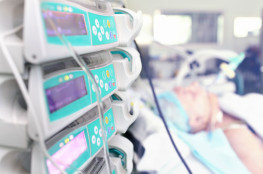Could Communication Apps and Devices Improve Patient Safety in ICUs?
17April2015
17April2015

Projects underway at hospitals across the country aim to use technology to improve safety and outcomes for patients in intensive care units (ICUs). The initiatives seek to change how ICUs operate, and increase patient and family involvement.
According to a recent article in The Wall Street Journal, evidence shows that patient and family participation can improve patient outcomes and safety. In turn, hospitals are putting an emphasis on treating patients with respect and dignity.
“We are broadening the definition of harm to include disrespectful care, which is every bit as important as an infection in the ICU,” Dr. Peter Pronovost said in the article. He is a critical care physician and director of the Armstrong Institute for Patient Safety and Quality at Johns Hopkins Medicine in Baltimore.
Johns Hopkins is one of four medical centers working on ICU redesign projects funded by the nonprofit Gordon and Betty Moore Foundation. A press release about John Hopkins’ Project Emerge states the goal is to redesign the “ICU workflow, culture and technology” by bringing together 18 disciplines, including clinicians, scientists, patients, and families.
The foundation of Project Emerge, according to the press release, is an application for tablets that combines information systems and monitoring data, allowing the medical team to see the data all at once. The app also updates a “harms monitor” that tracks patient tasks into seven separate areas – five medical areas, as well as respect and dignity and medical goals and care – and alerts medical staff to tasks that need to be done.
The harms monitor’s color chart shows the medical staff the status of actions that need to be taken to prevent patient harm. Red indicates action must be taken right away; yellow means the preventative action should be taken soon; and green means the action is complete.
The Wall Street Journal reported that Dr. Pronovost’s studies have shown that bloodstream infections linked to catheters can be reduced by 66 percent with a checklist of preventive steps, but those steps are not always followed. The harms monitor also would link staffers to reminders of the steps and treatments to prevent harm.
Project Emerge also has an app for patients and families, allowing patients to ask their medical team questions and learn more about their care. The app also gives families the opportunity to be more involved in their loved one’s care by uploading patient preferences and signing up to assist with certain daily care activities.
The Wall Street Journal reported that the University of California, San Francisco, is adopting the Project Emerge model from Johns Hopkins. Michael A. Gropper, a professor and interim chair of the Department of Anesthesia and Perioperative Care, told the newspaper that patients can be treated by 20 different clinicians, so their tablets are loaded with descriptions identifying them and their areas of expertise.
Other medical centers are using technology in efforts to improve patient care, including two in Boston, as reported in The Wall Street Journal article:
Brigham and Women’s Hospital has the Patient-Centered Toolkit, a Web-based portal on a bedside device that allows patients and families in the ICU and adult oncology units to access care plans and get more information on their condition, medications, and lab results. Patients can also use the device to ask their medical team questions.
Beth Israel Deaconess Medical Center is working on MyICU, a portal for patients and families to provide a real-time look at risks developing in its ICU.
The attorneys of Morrow Kidman Tinker Macey-Cushman, PLLC, are committed to patient safety and represent patients who have been harmed by preventable medical errors in Seattle and across Washington. Schedule a free consultation by calling us or contacting us online.